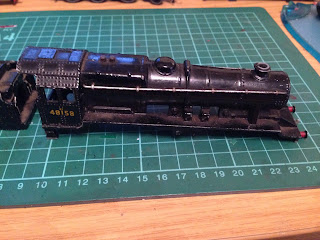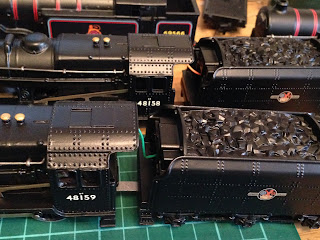**Warning - large update with lots of pictures!**
I've referenced the Silhouette Portrait in several recent posts and its results have attracted a fair amount of interest / attention. So this, rather large update, is all about the cutting machine and what I've managed to make it do so far!
First of all, the new EMU is now ready for exhibition, here it's been for a quick spin around the test track, coupled to the existing three car set...
The windows in this set were all pre-cut and although this made the process much quicker, the windows didn't quite line up in places due to not having the original source image to work from. Therefore the windows had to be cut smaller to allow for this, so cutting was still required - just less of it.
Here it can be seen that there is a slight difference in colour, this is due to a change of printer and after three trial runs, where the print was way too bright, this was the closest match I could get. Let's face it, in real life, the units would have discoloured in service!
Having declared cutting windows to be a reasonable success, I decided to move on and see if I could actually get a near-perfect cutting pattern for my next project - renovating old coaches.
I have a fair number of SR green coaches, some immaculate and some really only fit for the spares box. It seems a shame to let them go to waste so if I could restore them in some way, at least they will get some use.
To start, I dismantled a good brake coach so that I could get a decent colour image scan. With the image saved, I began colouring the window apertures black and then imported the file into the Silhouette software to design the cuts. For the door windows this is a rectangle, for the other windows a rounded rectangle shape was used and the cutting outline was positioned just around the inside of the black window shape.
Back to the source image, even with the best quality scan, the image was never going to be perfect. The doors were all re-drawn, nothing complicated just a couple of straight lines and three small rectangles for the hinges. The large handles were filled rectangles and the small handles are the only surviving bit of the original scan. This was recoloured and cleaned up before pasting into the new image, starting with a green rectangular background and continuing from there, copying and pasting each window set (window, door, window) along the design, still using the original scan to ensure alignment is correct.
Once the sides of the brake van were complete, a standard coach was then created, copying and pasting the same windows from before. No need to take a fresh scan of the coach, I was able to construct it purely by having the coach on my desk under the PC screen as I worked!
A few black & white draft prints were then made to ensure that the transfer will line up correctly with the windows - an easy job to get the alignment right. Then time to print the prototype. Here the sides of the brake coach are untreated and compared with the passenger coach that now has the vinyls fitted.
The fit and finish was good. The only issue was that the black edges of the windows, where I'd coloured them previously, could be seen. As the plotting was now correct, I was able to go back to the image and paint out all the windows, leaving a plain green side.
So with the prototype complete, I raided the scrap box looking for potential candidates, and came across three maroon coaches. I've had these for ages and never run them, mainly because they all look like this:
Rusty roofs, rusty wheels, scratched, dented, etc. Not exactly display material.
Now the good thing is that the maroon coaches are designed in exactly the same way as the green ones - all the windows are in the same place, all that was needed was a reasonable colour match, which I managed after three test prints, and to add stripes, a panel for the brake coach, the Guard sign on the door of the brake coach and modify the handles slightly (different shape on these)
For the best results, the surface has to be smooth - no rust, no loose paint...
Several coach sides were so bad that the only thing I could do was go back to bare metal, prime and then apply a quick coat of red...
Now, with the image finalised and printed, time to cut...
Matt vinyl this time (because I'd run out of gloss!)
After lining up the graphics by eye, making sure that the windows lined up before pressing home, they were smoothed into position. The only cuts being to the left & right edges, which I cut deliberately long to make the overlays easier to handle. The top & bottom of the overlay is folded over the edges to give a neat finish...
The sides were then sprayed with gloss lacquer - three coats required.
The coach roofs were also stripped to bare metal, straightened, given two coats of grey primer and three coats of lacquer. The underframes just needed the wheels cleaned and a quick blow over with satin black to refresh.
And this is the result...
Old vs refurb - not perfect but certainly near enough for me!
So this would normally be the end of my update. But there's more!
Now that I've established that the Silhouette cutter can restore my coaches, I wanted to see what it could do with the graphics I made a while ago for the 0-6-2 tanks.
I've been advised that my numbers (69568 & 69569) are wrong and were never produced, so only 69567 is correct. So this project also includes renumbering.
The graphics were imported into the Silhouette software again and measurements of the body were taken to ensure that the vinyls fit properly.
The test loco is probably the worst repaint of a 0-6-2 tank that I've ever seen (and I didn't do it)
A test run, using ordinary paper confirmed that the settings were correct...
Then it was time to cut again...
The last number set was produced using the Gill Sans font. Although this looks quite nice, it looks nothing like the original Dublo version, and I've never found a font that matches.
So it was back to Microsoft Paint with a high quality image of the side of an original 69567, the number was then cropped and enhanced electronically, then re-coloured ready to insert back into the design. I decided to go with 69566 and 69565 - to create these I simply copied and pasted a 6 and a 5 from the number I'd just created and pasted in place of the 7. The result is a reasonable reproduction of the original design...
We can't leave that body as it is, so it was stripped back to bare metal (the black paintwork was still underneath)
Primed...
Painted satin black...
And then the boiler bands and graphics were applied, before a coat of matt lacquer to seal everything.
At this point, the lacquer is still not quite dry - the final finish is now much better and the edges of the vinyls can hardly be seen.
The next job will be to paint the buffer beam and add the smoke box number, before refurbishing and refitting the handrails. This body will then be exchanged with one of the other black 0-6-2s and eventually all three will be renumbered.
The Silhouette Portrait certainly is a useful bit of kit. The software isn't the easiest to live with, primarly because you can't copy & paste into the software, everything has to be opened as an image file. I think the idea is that you're supposed to use the Silhouette templates that are commercially available but I've proved that it can be made to work for producing graphics to revitalise my rolling stock. My painting talents are limited so this is a low-cost way for me to get my tatty looking coaches back into use.
Finally, here's the machine in action, cutting the EMU sides:






























































